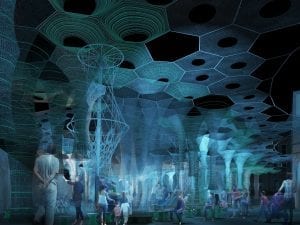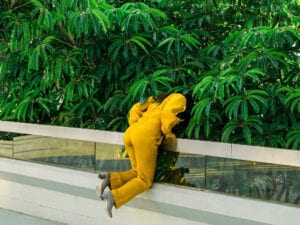“I was very drawn to performance. The minute I did it, for the first time, I was drawn to it, to find the work by using my body in relation to space and objects. The way I would arrive at that would be total improvisation, picking up an object and working with it. I was just simply drawn to it, irresistibly,” says Joan Jonas (b. 1936). The American artist and pioneer of video and performance art was one of the most important names to emerge from the late 1960s and 1970s. Video taped pieces such as Organic Honey’s Visual Telepathy (1972) and Vertical Roll (1972) start with a distinct visual: a bar slides unevenly down the centre of a screen. At the top, a small portion of Jonas’ face becomes visible, before gradually revealing her profile. Simultaneously, a spoon enters the scene as the artist initiates a rhythmic banging against an unseen surface. Throughout the sequence, Jonas’ body is made fragmented, falling in and out the frame. The artist asks questions such as: how do we perceive our bodies? How does this change through a camera lens? What is technology’s effect on the image identity of women?
The Museum of Modern Art presents Joan Jonas: Good Night Good Morning, the artist’s most comprehensive retrospective in the United States, spanning more than 50 years of her remarkable career. On view from 17 March through 6 July, the show features a selection of works produced from 1968 to the present, including drawings, photographs, films, major installations and performances, many of which have been revisited and reconfigured by the artist for this exhibition. Organised chronologically, the display highlights four major themes in Jonas’ work: performance, technology, literature and ecology. In addition, it foregrounds how she uses her own works as archival material — with each project building on those that preceded it — completely transforming and restaging them into other mediums.

The show opens with a 16mm film projection of Wind, Jonas’ first ever piece (1968). The recording shows a Long Island beach covered in snow. A series of figures fight against the wind, holding hands, attempting to put on coats, moving enigmatically against severe weather conditions. The artist did not anticipate the conditions, explaining, “it happened to be the coldest day of the year.” The elements dictate the movements of the performers, resulting in an abstract improvisation. After attending workshops from choreographers at Judson Dance Theater, Jonas refocused her practice, integrating several disciplines into one. She says, “I felt that my sculpture lacked something that live performance or action had. So I switched, I became entranced with form. I thought I could make something that didn’t have to be an object.”
Elsewhere, we see iconic works such as Mirror Piece I (1969) and Mirror Piece II (1970), documenting performers carrying mirrors in choreographed sequences. Individuals reflect the audience, incorporating them into the space of the action. Jonas deployed the mirror as a viewing device and tool for reflecting on identity and self-perception. She notes, “I consider myself partly an imagist — I get that word from imagist poetry.” She references the term, coined by modernist writer Ezra Pound in 1912, favouring its clarity of expression, “combining two or three images together.” Mirror does precisely this: a viewer’s gaze is triangulated, moving between the subjects carrying the object, the reflection, and the item itself.

The exhibition features multimedia installations that address environmental themes of ecological crisis. Reanimation (2010-2013) is one of Jonas’ many collaborations with jazz musician Jason Moran. Shot on Norway’s Lofoten Islands, four videos depict dreamlike images of dark tunnels, glaciers and icy roads, intersplicing them with footage of the artist drip-painting on snow or drawing with ice and black ink on paper. Moving Off the Land (2019) also pays tribute to the oceans and their creatures, showing footage of deep sea creatures and the sea. This is combined with poetry and prose texts by writers such as Herman Melville and Emily Dickinson in addition to music by Ánde Somby and María Huld Markan Sigfúsdóttir.
Finally, we come across two new works: To Touch a Sound (2024), informed by David Gruber’s latest research on the consciousness of whales, and By a Thread in the Wind (2024), a series of newly made kites. The latter work, according to the artist, can be used “to judge, distance, to signal, to carry fire, to banish evil, for communication, to carry a child, to carry an adult to bear a message.” Although these are not kites to be flown in the wind, they pair perfectly with Jonas’ inaugural work, sustaining a cohesive narrative throughout the exhibition. As viewers, we are reminded of Jonas’ trailblazing role in the realm of performance art. Good Night Good Morning invites us into surreal and dreamlike realms, immersing us in a host of narratives that engage with gesture, imagery, sound and symbolism. Throughout, we engage with an interconnected world that challenges the boundaries of genre in the most dynamic of ways.
Joan Jonas: Good Night Good Morning | 17 March – 6 July
Image Credits:
Joan Jonas. Mirror Piece I. 1969. Performance, Bard College, Annandale-on-Hudson, NY. Courtesy the artist
Joan Jonas. Delay Delay. 1972. Photo: Gianfranco Gorgoni
Joan Jonas. Mirage. 1976. University Art Museum(now UC Berkeley Art Museum and Pacific Film Archive), Berkeley, 1980. Performer: Joan Jonas. Assistant: Elsie Ritchie. Photo: Benjamin Blackwell. Source: Joan Jonas Studio





